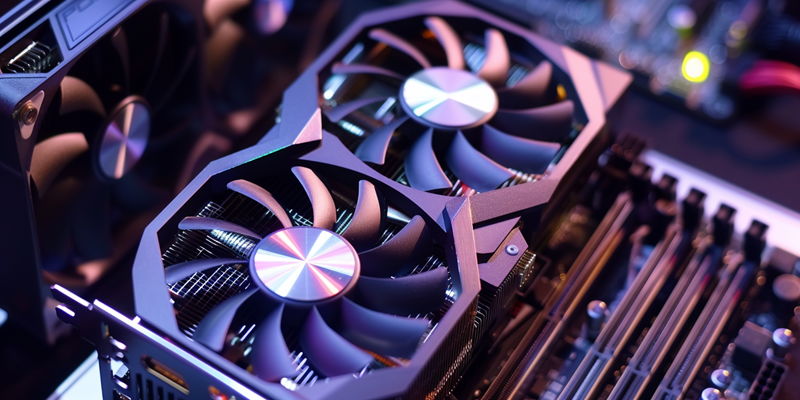As the tech world brims with expectation for Nvidia’s upcoming series of Blackwell graphics cards, recent leaks concerning their VRAM specifications have sparked discussion. Informed by the reputed source Moore’s Law is Dead, industry spectators and consumers alike are parsing the implications of the rumored VRAM configurations to deduce the potential of these forthcoming GPUs.
Understanding Nvidia’s Blackwell Series
The Flagship RTX 5090 Model
Delving into the anticipated flagship GPU from Nvidia, the RTX 5090 is said to retain the same 16GB VRAM as its predecessor, the RTX 4090, along with a 256-bit memory interface. The decision to maintain VRAM capacity unchanged begs analysis. Foremost, it suggests confidence in the current memory architecture’s adequacy to handle imminent gaming requirements. However, it concurrently raises questions about Nvidia’s strategy in leveraging performance enhancements elsewhere in the GPU to entice buyers.
The RTX 5080 and Its Significant VRAM Upgrade
The RTX 5080’s purported increase to 16GB of VRAM signifies a conspicuous amplification over the existing RTX 4080, which is currently outfitted with 12GB. This amplification suggests a marked performance uplift, hinting that the RTX 5080 may occupy a closer stance to the flagship model than traditionally seen. The enhancement indicates Nvidia’s intent to blur the lines within its GPU hierarchy, potentially offering flagship-like experiences at a more accessible price point for immersive gaming and intensive applications.
Balancing VRAM Configurations with Future Gaming Needs
The GPU tier estimated to lie midway in the new lineup, potentially labeled RTX 5060 or RTX 5070, is rumored to feature an 8GB VRAM specification. This sparks concern about longevity in an era where game complexities and visual prowess are escalating rapidly. The adequacy of 8GB of VRAM is being questioned, with many arguing it may not suffice in a few years’ time, underscoring a debate about whether Nvidia is calibrating its lower-end offerings accurately against future gaming landscapes.
Consumer and Industry Reactions to the Leak
Gaming Community’s Perspectives
The leaked specifications have elicited a combination of excitement and wariness from the gaming community. While the high-end models hold promise for state-of-the-art gaming experiences, there’s trepidation regarding the prospects of mid-range GPUs, particularly about the sufficiency of 8GB VRAM in meeting the heavy demands of future games. Players are weighing in, debating gaming needs versus technological progression with regards to VRAM.
Industry Analysts Weigh In
Industry analysts provide a broader context by dissecting Nvidia’s VRAM configurations to decipher their strategic placement in the market. The consensus tends to acknowledge the strategy behind the formidable VRAM for high-tier GPUs. However, they also underscore that Nvidia’s approach with mid-tier GPUs needs careful consideration so as not to undermine the consumer’s long-term investment in gaming hardware.
The Implications of VRAM on Gaming Laptops
A Shifting Gaming Laptop Landscape
The shift heralded by the contemplated VRAM upgrade of the RTX 5080 could be recalibrating the conventional gaming laptop hierarchy. Such a move might signal a more democratized approach to performance, allowing enthusiasts and professionals to access near-flagship experiences without venturing into the top-tier price bracket. Analysts are closely monitoring this trend, anticipating it could disrupt the gaming laptop market by redefining performance expectations.
Performance Versus Future-Proofing
The Blackwell series’ VRAM configuration debate is indicative of a broader conundrum in the tech industry: the equilibrium between current performance and future-proofing. The unchanged VRAM in top-tier models contrasts with the substantial upgrade in the second-tier, and the potentially inadequate provision in lower tiers raises questions about Nvidia’s prioritization and foresight. This leads to a nuanced debate on how consumers should direct their investments to safeguard against rapid technological obsolescence.
The Dynamic Nature of the Tech Industry
Today’s Edge, Tomorrow’s Standard
The tech industry is abuzz with expectations as Nvidia prepares to unveil its next-gen Blackwell graphics cards. Recently, a leak revealed potential VRAM specs, causing a stir amongst tech enthusiasts and potential buyers. The reputable leak source Moore’s Law is Dead provided the details leading to extensive speculation on the capabilities of these new GPUs.
Nvidia’s upcoming offerings are speculated to feature varying VRAM capacities, critical for a graphics card’s ability to handle high-resolution textures and complex tasks in gaming, rendering, and A.I. applications. These leaks suggest that Nvidia is gearing up to offer a range of graphics cards that could cater to different market segments, from hardcore gamers to professional content creators and data scientists.
As the tech community analyzes these rumors, there is a sense of anticipation for how these GPUs will stack up against the current models and how they will shape the technological landscape. Nvidia’s history of pushing boundaries with each release adds to the excitement, though official details have yet to be confirmed. Whether these leaks will prove accurate remains to be seen, but they have certainly sparked conversations about the future capabilities of Nvidia’s graphics technology.

